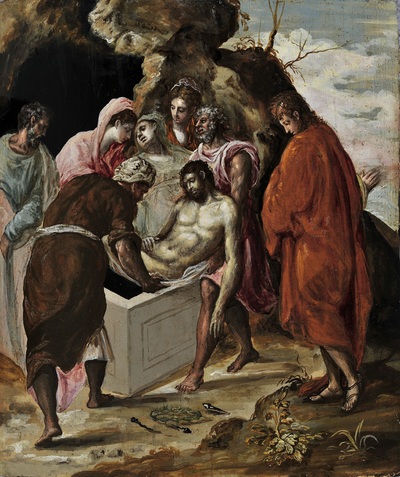Javascript must be enabled to continue!
Η ταφή του Χριστού
View through Europeana Collections
Made in Venice, this work is representative of a particular phase in the artist's development, that is, at a time when he sought to assimilate the teachings of the art of the Renaissance: the articulation of space in perspective, emphasised here by placing the marble sarcophagus on an angle and by the way the figures stand in space, as well as by the modelling of volumes through chiaroscuro and the shadows projecting against the ground. Of classical proportions, Christ's body is depicted almost in the guise of an ancient statue. The profuse colour and dramatic expression culminating in the Virgin's fainting are traits of the Venice Renaissance art. El Greco borrowed many elements in his composition from other Renaissance artists but so masterfully has he arranged them that this is hardly noticeable. The only elements reminding us of the Byzantine provenance of the painter's art are the wood panel on which the painting is made and the medium of egg tempera, combined here with oil – a medium characteristic of the Italian, especially Venetian Renaissance.
National Gallery - Alexandros Soutsos Museum
Title: Η ταφή του Χριστού
Description:
Made in Venice, this work is representative of a particular phase in the artist's development, that is, at a time when he sought to assimilate the teachings of the art of the Renaissance: the articulation of space in perspective, emphasised here by placing the marble sarcophagus on an angle and by the way the figures stand in space, as well as by the modelling of volumes through chiaroscuro and the shadows projecting against the ground.
Of classical proportions, Christ's body is depicted almost in the guise of an ancient statue.
The profuse colour and dramatic expression culminating in the Virgin's fainting are traits of the Venice Renaissance art.
El Greco borrowed many elements in his composition from other Renaissance artists but so masterfully has he arranged them that this is hardly noticeable.
The only elements reminding us of the Byzantine provenance of the painter's art are the wood panel on which the painting is made and the medium of egg tempera, combined here with oil – a medium characteristic of the Italian, especially Venetian Renaissance.
Related Results
Religious Celebration
Religious Celebration
By Christos Kangaras (1915 – 2003), Icon, oil on canvas
84 x 102 cm
An illustration depicting a Greek religious festive celebration by the artist Christos Kangaras. With the excep...




